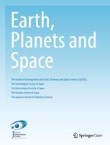Earth, Planets and Space welcomes submissions to this special issue on “Magma Migration and Eruptions in a Volcanic Group: Case Studies for the 2017-2018 Activity of the Kirishima Volcano Group and Other Global Examples”.
There are quite a few volcanic groups in the world, where multiple edifices exist close to each other. The linkage of the magma supply system beneath such a volcanic group and the relationship of eruptive activity among the edifices are of great interest.
Mt Kirishima is an example of a volcanic group consisting of more than twenty isolated eruption centers forming small edifices. Shinmoe-dake, one of the active cones, had a magmatic eruption in 2011. Various instruments were deployed around Shinmoe-dake in order to provide multidisciplinary observations of the eruptive activity. These instruments were also present during the latest 2018 Kirishima eruptions.
In the 2018 activity, eruptions occurred at two edifices - Shinmoe-dake and Io-yama. In the former, following the explosive eruption in 2011 and small explosive events in 2017, an effusive eruption occurred, which was accompanied by subsidiary Vulcanian eruptions. The latter caused phreatic explosions - the first eruptive activity since 1768. The abundant observational data and detailed investigation of the 2018 eruption could provide the opportunity to improve our understanding of the magmatic system of the volcanic group.
This special issue aims to discuss an up-to-date picture of magma systems below volcano groups and the mechanisms of the associated eruptions, based on the geophysical, geological, or geochemical datasets. We expect submissions of papers on the Kirishima volcanic group, including Shinmoe-dake, Io-yama, and other edifices, and on other volcanic groups worldwide. We also welcome fundamental researches on both subsurface and subaerial eruption processes. Papers discussing disaster management and social impact, especially considering the existence of multiple active edifices, are also highly welcomed.
Submission Instructions
Before submitting your manuscript, please ensure you have carefully read the submission Guidelines Earth, Planets and Space. The complete manuscript should be submitted through the Earth, Planets and Space submission system. To ensure that you submit to the correct special issue please select the appropriate special issue in the drop-down menu upon submission. In addition, indicate within your cover letter that you wish your manuscript to be considered as part of the special issue on 'Magma Migration and Eruptions in a Volcanic Group: Case Studies for the 2017-2018 Activity of the Kirishima Volcano Group and Other Global Examples'. All submissions will undergo rigorous peer review and accepted articles will be published within the journal as a collection.
Deadline for submissions: 31 March 2023
Lead Guest Editor
Takayuki KANEKO, The University of Tokyo, Japan
Guest Editors
Mie ICHIHARA, The University of Tokyo, Japan
K.I. KONSTANTINOU, National Central University, Taiwan
Antonio COSTA, National Institute of Geophysics and Volcanology, Italy
Yasuo MIYABUCHI, Kumamoto University, Japan
Koki AIZAWA, Kyushu University, Japan
Rapid publication: Online submission, electronic peer review and production make the process of publishing your article simple and efficient
High visibility and international readership in your field: Open access publication ensures high visibility and maximum exposure for your work - anyone with online access can read your article
No space constraints: Publishing online means unlimited space for figures, extensive data and video footage
Authors retain copyright, licensing the article under a Creative Commons license: articles can be freely redistributed and reused as long as the article is correctly attributed
For editorial enquiries please contact: eic@earth-planets-space.org.
Sign up for article alerts to keep updated on articles published in Earth, Planets and Space - including articles published in this special issue!
















